Content for TS 23.433 Word version: 19.0.0
0…
4…
7…
8…
9.2…
9.2.2.3…
9.2.3…
9.2.4…
9.3…
9.3.2.2…
9.3.3…
9.3.4…
9.4…
9.5…
9.5.3…
9.5.4…
9.6…
9.7…
9.7.3…
9.7.4…
9.8…
9.9…
9.10…
A…
C…
9.5 SEALDD enabled data storage
9.5.1 General
9.5.2 Procedure
9.5.2.1 Data storage creation
9.5.2.2 Data storage reservation
9.5.2.3 Data storage query
9.5.2.4 Data storage management
9.5.2.5 Stored data transfer between VAL servers via SEALDD server
...
...
9.5 SEALDD enabled data storage p. 50
9.5.1 General p. 50
The following clauses specify procedures, information flows and APIs for SEALDD enabled data storage, the stored data can be queried by the creator or the other network functions for context or content transfer.
9.5.2 Procedure p. 50
9.5.2.1 Data storage creation p. 50
Pre-conditions:
- The VAL server has discovered and selected the SEALDD server by CAPIF functions.
- The SEALDD client has discovered and selected the SEALDD server as specified in clause 9.4.3.
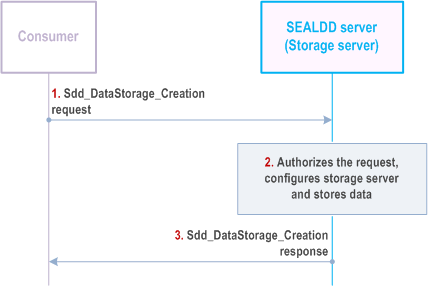
Step 1.
The VAL client/server determines to use SEALDD storage service, which could store/host data on behalf of the VAL client/server. The consumer (e.g. SEALDD client, VAL server) send a Sdd_DataStorage_Creation request to the SEALDD server. The request includes the data to be stored and information associated with the data, such as access control policy, expiration time of the storage, etc. The consumer may also specify in the request the management or status information of the data storage that is required (e.g., information about how often the stored data is accessed or managed).
Step 2.
The SEALDD server checks for the authorization of the storage service creation request. If the request is successfully authorized, then the SEALDD server configures the storage service based on the request and stores the data at the storage server. If status information of the stored data is requested, the SEALDD server will start to monitor the status of the stored data, such as to track the accesses to the data for the data access status.
Step 3.
The SEALDD server sends a response to the requesting consumer (e.g. SEALDD client, VAL server). The response indicates if the request is accepted and the identifier of the stored data (if applicable). Upon receiving the response, the requesting consumer may create a record for the stored data.
9.5.2.2 Data storage reservation p. 51
Pre-conditions:
- The VAL server has discovered and selected the SEALDD server by CAPIF functions.
- The SEALDD client has discovered and selected the SEALDD server as specified in clause 9.4.3.
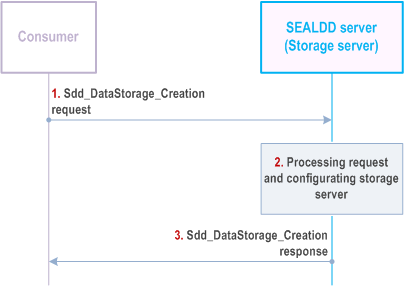
Step 1.
The consumer (e.g. SEALDD client, VAL server) send a Sdd_DataStorage_Creation request to the SEALDD server. The request includes the VAL service ID and the data length.
Step 2.
The SEALDD server checks for the authorization of the storage service Creation request. If the request is successfully authorized, then the SEALDD server allocates and reserves the address for data storage.
Step 3.
The SEALDD server sends a response to the requesting consumer (e.g. SEALDD client, VAL server). The response indicates if the request is accepted and the address for data storage. Upon receiving the response, the stored data may be delivered via push mode from the requesting consumer to the SEALDD server.
9.5.2.3 Data storage query p. 51
Pre-conditions:
- VAL client/server has stored data in SEALDD server.
- The consumer (e.g. SEALDD client/VAL server/other SEALDD server) requesting the stored data has got the identifier of the stored data (e.g. via application layer signalling or other mechanisms).
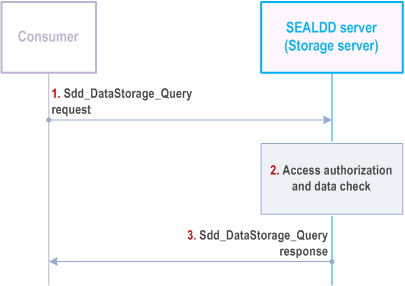
Step 1.
The consumer (e.g. SEALDD client/VAL server/other SEALDD server) sends a Sdd_DataStorage_Query request to the SEALDD server with the identifier of the stored data.
Step 2.
Upon receiving the request, the SEALDD server performs an authorization check to verify if the requested data (according to the data access control policy) can be accessed by the consumer. The SEALDD server will also check whether the stored data is expired.
Step 3.
If the verification was successful, the SEALDD server responds with the requested data.
9.5.2.4 Data storage management p. 52
Pre-conditions:
- The SEALDD service is configured to track and maintain data storage access information (i.e. status information).
- A storage service creation request procedure from the consumer (e.g. SEALDD client, VAL server) to the SEALDD server has been performed. The request includes a subscription to data storage access information (i.e. status information).
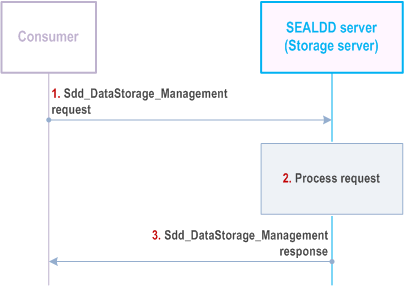
Step 1.
Based on the received stored data status information, the requesting consumer (e.g. SEALDD client, VAL server) determines to perform a management operation, such as to update, refresh, or delete the stored data. The VAL client/server sends a Sdd_DataStorage_Management request to the SEALDD server to perform the determined management operation.
Step 2.
The SEALDD server processes the storage management request. If the request is accepted, the SEALDD server performs the required management operation on the stored data.
Step 3.
The SEALDD server sends a response to the requesting consumer (e.g. SEALDD client, VAL server) with the result of the management operation, which may include updated information of the stored data.
9.5.2.5 Stored data transfer between VAL servers via SEALDD server p. 53
Pre-conditions:
- The source VAL server already obtains the serving target SEALDD server of the target VAL server.
-
The source VAL server may have stored data to the source SEALDD server and obtained the identifier of the stored data by invoking Sdd_
DataStorage_ API in clause 9.5.2.1.Creation
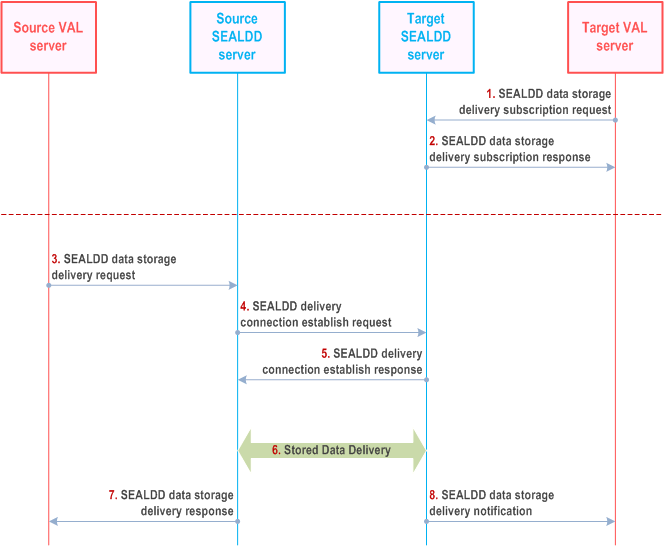
Step 1.
The VAL server sends a SEALDD data storage delivery subscription request to its serving SEALDD server with the VAL server information, and the VAL server address to receive the stored data delivery.
Step 2.
The SEALDD sever responds to the requested VAL server with the subscription result, if successful, the response includes the subscription ID, expiration time.
Step 3.
The source VAL server determines to use the stored data transfer service provided by the serving SEALDD server. The source VAL server invokes a SEALDD data storage delivery request, the request includes the identifier of the stored data needed to be delivered, or the stored data (i.e., the source VAL server does not use data storage creation to store data to the source SEALDD server before), the target VAL server information and the target SEALDD server information.
Step 4.
The source SEALDD server sends a SEALDD delivery connection establish request towards the target SEALDD server with the source SEALDD server information, the target VAL server information, and the supporting transport layer protocols for data delivery.
Step 5.
The target SEALDD server responds to the source SEALDD server with the traffic descriptor of target SEALDD server (e.g. address/port, transport layer protocol). The target SEALDD server may allocate the storage for the target VAL server.
Step 6.
Upon receiving the traffic descriptor of target SEALDD server, the source SEALDD server sends the requested data corresponding to the identifier of the stored data to the target SEALDD server.
Step 7.
The source SEALDD server responds to the source VAL server with the result of data delivery.
Step 8.
The target SEALDD server sends the received data to the target VAL server via the notification message. Optionally, the target SEALDD server may only send the identifier of the received data to the target VAL server in the notification message, the target VAL server can obtain the stored data originated from the source VAL server, by invoking the Sdd_DataStorage_Query API to the target SEALDD server, as specified in clause 9.5.2.2.